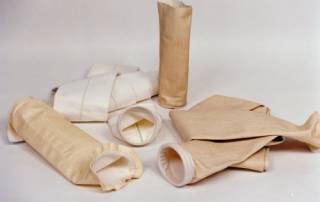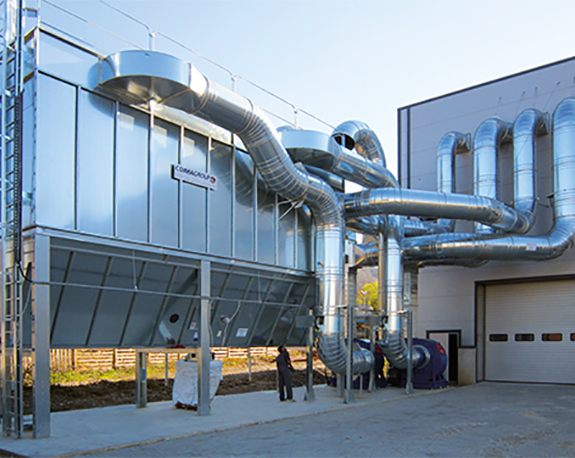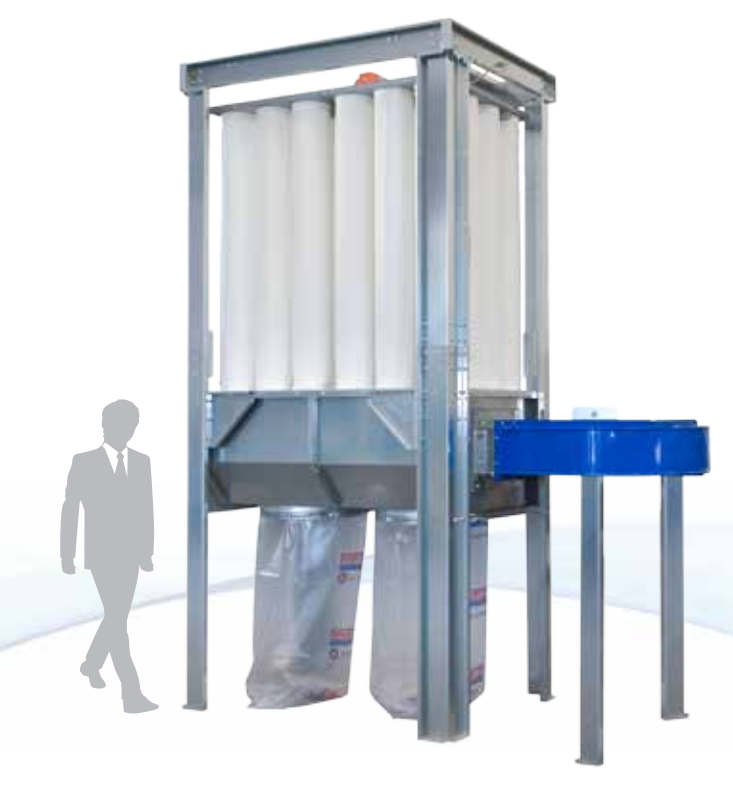By the name alone, it’s easy to guess what a Dust Collector is designed to do. However, there’s more to just sucking up waste materials when it comes to these essential machines. The most important aspect of dust collector design is what kind of material is being collected. Wood chips will require a different kind of filtration than metal shavings, just as sand has different requirements than lead oxide or salt. Every material has specific properties which affect the velocity at which they must be collected, and the filtration method by which they are pulled from the air stream.
Let’s start with a list of basic dust collector types:
- Baghouse Dust Collectors
- Cartridge Dust Collectors
- Wet Collectors/Air Scrubbers
- Mist Collectors
- Cyclones & Inertial Separators
- Electrostatic Precipitators
These six concepts cover all of the variations of collectors and collection devices available in the market today. This series of articles will explain the first five of these in detail, and describe the various types of each collector. Total Air Energy provides a wide selection of each of these systems, and you will find links to these options throughout the text.
Baghouse Dust Collectors
The first dust collectors relied upon bag filters which trapped dust and particles blown through a fan and into the bag. An early advancement in this design was the use of a frame to support a series of envelope bag filters which worked in parallel to trap particulate matter as it was drawn through the filters by a fan placed on the clean side of the collector housing.
Assortment of Bag Filters

POSITIVE PRESSURE VS. NEGATIVE PRESSURE
The main difference between these two concepts is the location of the fan; positive pressure arrangements blow air through the filters (located upstream), whereas negative pressure arrangements draw the air through the filters from the other side (located downstream). Negative pressure designs require an enclosure from which to create a negative pressure space (vacuum) to draw the air through the collection system. This enclosure provides greater control of the process, and allows for a number of advanced features for safety and functionality.
One of the primary advantages of negative pressure systems is the efficiency of a clean air fan design versus a dust-laden air/material handling fan. Typically, a negative pressure fan (backward inclined or backward curved) is 30% more efficient than fans designed for the rough environment and looser tolerances of conveying dirty air.
ENCLOSURELESS BAGHOUSE COLLECTORS
If you have been in a small woodshop with a dust collector, you have probably seen a common type of bag collector: the enclosureless baghouse. These are very affordable, but can often be ineffective as dust collectors. The filters need frequent cleaning, which requires the collector be shut off and the bags beaten with a stick or shaken by hand. The bags themselves can also be poor filters, which defeats the purpose of having a dust collector in the first place. More advanced enclosureless systems offer a vibrating ‘shaker’ mechanism which cleans the filter bags whenever the system is shut off. Online cleaning is not possible with this type of collector.
To minimize on space, the most common models have an extremely high air-to-cloth ratio. This means that a lot of air must pass through a small amount of filter media in the bag. This often results in fine dust being forced through the filter bag and a tendency for the filter media to load up quickly. This can be dangerous, as fine wood dust is prone to explode under certain conditions. In fact, aerosolized wood flour (very fine wood dust) is TEN TIMES more explosive than gasoline vapors!!
When choosing an enclosureless baghouse collector, it is important to understand the risks of poor filtration and select a model with lower air-to-cloth ratio and the correct filter media for the job. More, smaller filters are better than fewer large filters. Contact us to determine the best collector for your workshop.
COIMA USA SHK Series
NFPA guidelines require Enclosureless Dust Collectors to be located 20’ from any area routinely occupied by personnel or used as a means of egress, and the equipment cannot exceed 5,000 CFM airflow capacity.
NFPA Standard 664 8.2.2.6.1.6
ENCLOSED BAGHOUSE COLLECTORS
An Enclosed Baghouse Dust Collector is the most common and most versatile type of dust collector available on the market. From a small collector designed for a few of machines in a woodshop to massive collectors at major industrial sites processing millions of cubic feet per minute of dust-laden air, the enclosed baghouse offers the most coverage for dust collection needs worldwide.
COIMA USA UPD Series

UPD Series Pneumatically-Cleaned Large Baghouse Dust Collector
These collectors function as part of a negative pressure system, with the fan typically mounted on the ground adjacent to the collector with ducting running from the clean air outlet to the fan inlet. Smaller collectors sometimes employ a fan mounted directly to the top of the clean air plenum (the large box atop the collector surrounding the clean air side of the filters). Filter types include envelope bag, fabric bag, and pleated bag designs. Outlet airflow can be exhausted to the environment, or returned to the building through ductwork.
Certain processes may require special fire suppression and explosion protection equipment. Total Air Energy recommends EcoMAXX safety products in all installations requiring these devices. Contact us today to learn more about preventing disaster in your workplace.
The most common and versatile of these is the fabric bag, which is a sleeve of filter fabric surrounding a steel wire cage. This “socks in a box” design offers the widest range of sizes, filter media types, and features a pneumatic cleaning system which provides continuous operation of the dust collection system while cleaning. The steel cage provides a support from inside the filter sleeve while dust builds up on the outside, forming a dust cake. The filter media material varies depending on the process characteristics. These include type of dust, size of dust particles, temperature of air & dust, and oil content or humidity of the airstream. With a variety of materials and treatments, we can provide filters which can withstand a number of conditions including oil or water content and temperatures up to 500° F (260° C).
When the filter media is cleaned, a high-pressure pulse of compressed air is shot down the center of the sleeve from the clean air side. This rapid change in pressure and reverse flow inflates the filter sleeve to pulse off the dust cake. The change in airflow and the change in the shape of the filter media helps provide an effective method of filter cleaning that cannot be reproduced with other filter types.

